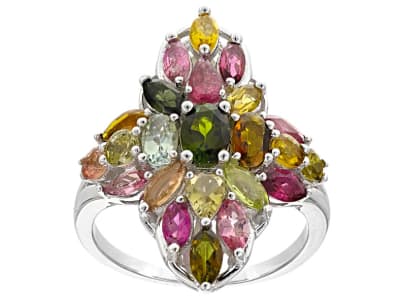Tourmaline represents a large group of related mineral species that exhibit many unusual optical and physical properties. The tourmaline group consists of buergerite, chromdravite, dravite, elbaite, feruvite, liddicoatite, rossmanite, schorl and uvite. The Elbaite series includes rubellite, indicolite, paraíba, and watermelon tourmaline. Chemically more complex than most minerals, tourmaline exhibits a substantial range of colors and varieties. Some varieties exhibit two or more colors in the same stone.
General Information
Tolerance:(+0.011/-0.009)
LWUV: Inert to weak red to violet
Tourmaline Colors
-
 Bi-color
Bi-color -
 Black
Black -
 Blue
Blue -
 Blue
Blue -
 Brown
Brown -
 Colorless
Colorless -
 Gray
Gray -
 Green
Green -
 Green
Green -
 Green
Green -
 Green
Green -
 Multi-color
Multi-color -
 Orange
Orange -
 Pink
Pink -
 Pink
Pink -
 Purple
Purple -
 Purple
Purple -
 Red
Red -
 White
White -
 Yellow
Yellow
Tourmaline Spectra
We acknowledge the significant scientific contributions of John S Harris, FGA to the study of gemstone spectra and with deep appreciation to him, acknowledges the use of his images and related notes about gemstones and their spectra in the educational materials on this website.
Alternate Names
Achroite, Bi-Color Or Parti-Colored, Chrome Tourmaline, Dravite, Elbaite, Fluor-Buergerite, Indicolite, Liddicoatite, Povondtaite, ParaBa Tourmaline, Rubellite, Schorl, Uvite, Verdelite, Watermelon
Countries of Origin
Tanzania, United Republic Of; Myanmar; Afghanistan; Russian Federation; Sri Lanka; United States of America; Madagascar; Zambia; Kenya; Thailand; Congo; India; Sweden; Mozambique; Pakistan; Morocco; Unknown; China; Namibia; Brazil; Mexico; South Africa; Australia; Nigeria
History
The word tourmaline comes from the ancient Sinhalese word, turamali which means "stone of many colors." We know that tourmaline is a gemstone that's found in a veritable rainbow of options. But how about a tourmaline that has that rainbow of colors within a single crystal? Multi-colored tourmaline is found in combinations like gold with pink and red, or green, gold and red. It's called by many names, parti-colored, bi-color, tri-color, and even watermelon in the case of the most often seen duo of pink and green! Whether you choose tourmaline with a single color, a stone with two colors or a stone with many colors, tourmaline is well worth owning. It may be called a myriad of things by experts. We jewelry lovers call it wonderful.
Care
Tourmaline is very wearable with a Mohs hardness of 7 - 7.5. It's easy to wear and easy to care for. Avoid steam or ultrasonic cleaners and avoid sudden temperature changes. Tourmaline will respond well to warm, sudsy water, a thorough rinse and a soft-cloth dry. Avoid harsh chemicals; use only gentle soap.
More About Tourmaline
Ancient civilizations needed to explain the world in which they lived, very much as we do today. Without modern scientific tools, they had to find more fanciful explanations for earth's wonders. According to legend, tourmaline is found in many colors because it traveled along a rainbow and picked up its colors along the way. Tourmaline was a valued element in ancient medicine, especially in the Far East where it was believed useful as a remedy for all manner of illnesses.
Species/Variety
Cat's Eye Tourmaline
Watermelon Tourmaline
Watermelon tourmaline is an interesting multi-colored elbaite variety. Gems are usually fashioned in thin polished slices to display the crystal's concentric color rings. If you use your imagination, the green represents the skin of the watermelon, white makes up the rind, and pink is the sweet fruit. Incredibly, the colors of watermelon tourmaline are 100% natural, a rare occurrence in nature that makes the gem highly collectible.
LWUV: Variable
Paraiba
Paraíba tourmalines are copper bearing elbaite tourmaline that are neon to electric blue, intense green, and vivid purple to violet in color. Heitor Dimas Barbosa headed up a team of 13 garimpeiros in search for tourmaline in 1982 outside the village of São José da Batalha in north central Paraíba State, Brazil. The first Paraíba tourmaline was found at the Batalha Mine in 1987 and the gemstone first appeared at the Tucson gem shows in 1990. Cuprian tourmaline was later found in other locations in Brazil, Nigeria, and Mozambique that also bear the name Paraíba tourmalines. The blue and bluish green colors are due to Cu2+. The additional presence Mn3+ causes color absorption in the spectra and produces violet to purple colors. Heat can be used to intensify color and included stones are fracture filled with oil or polymers to improve clarity.
LWUV: Variable
Multi-Colored Tourmaline
Multi-colored tourmaline is a variety of tourmaline containing two or more colors displayed in one crystal. Green and pink is the most prevalent combination, but others are possible.
LWUV: Variable
Elbaite
The tourmaline family consists of at least 14 distinct minerals, but the variety elbaite accounts for nearly all gem-quality tourmaline. It was named as a result of the colored and colorless tourmalines found on the picturesque island of Elba off the western coast of Italy--history buffs know this island as the place where Napoleon Bonaparte was exiled in 1814. Although best known in shades of green and red, elbaite can also be blue, purple, yellow, or colorless. Notable varieties of elbaite include rubellite, green tourmaline, indicolite, watermelon tourmaline, Paraiba tourmaline and colorless.
LWUV: Inert
Dravite
Dravite is the dark yellow to brown variety of tourmaline.It is named after a deposit in modern day Slovenia near the Drave river.
Optical Phenomena
Cat's Eye
The term cat's eye, or chatoyancy, is used to describe a phenomenal optical property in gemstones, in this case tourmaline. The effect, when present, appears as a bright, narrow slit similar to the pupils in the eyes of your favorite feline. This phenomenon is caused by parallel fibrous or needle-like inclusions that interfere with the passage of light throughout the crystal, scattering and reflecting light back to the viewer as a thin line. Cat's eye tourmaline can occur in many colors but particularly in green and pink varieties.
LWUV: Variable Pink: inert to very weak red to violet



















